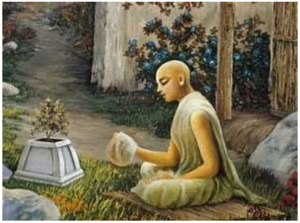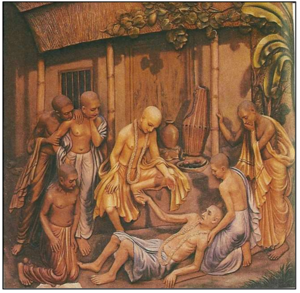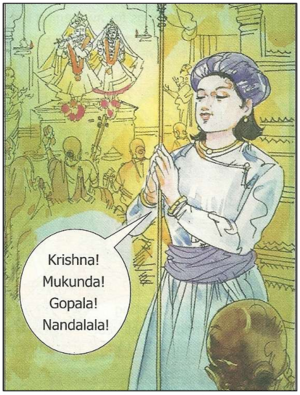Talk:Religious Affiliation
By Vishal Agarwal
Many Bhakti Sants inspired deep spiritual connection across communities, with individuals from other faiths embracing their teachings and participating in their devotional traditions out of love and reverence. Sant Kabīr was raised by Vaiṣṇava Sant Rāmānanda. Sant Dādū was likewise born into a Muslim family but was initiated by a Guru. There are also examples of Bhagavān manifesting to bless and affirm their Bhakti.
Haridāsa Ṭhākura, the Muslim who would not give up his faith in Kṛṣṇa One of the most prominent disciples of Caitanya was Haridāsa Ṭhākura, who was born to Muslim parents in Budan, Jessore District (now in Bangladesh) in the year 1464 CE. His original Muslim name is not known or remembered. In the Gauḍīya Vaiṣṇava tradition, he is considered a dual incarnation of Bhagavān Brahmā and Bhakta Prahlāda. His father, Malai Qāzī, was a Muslim magistrate – a high position in the Muslim Sultanate of Bengal. However, at a very young age, Haridāsa was influenced to become a devotee of Kṛṣṇa by Advaita Ācārya. Initially, some people opposed his induction into the Vaiṣṇava community, but his piety won over most of them over time. It is said that he would chant the name of Kṛṣṇa 300,000 times every day. Impressed with his devotion, Caitanya Mahāprabhu, whom Haridāsa accepted as his Guru, bestowed upon him the title ‘Nāmācārya’ and deputed him to lead groups of chanters in Navadvīpa. Bengal in those times was ruled by a Muslim Sultan Ḥusain Shāh. He was comfortable with serving in his administration, but would not tolerate public displays of Hinduism, even though Hindus formed a majority of his kingdom’s population.
Alarmed at the public chanting of Kṛṣṇa’s names by the masses, he perceived Haridāsa Ṭhākura as a threat. Moreover, the fact that Haridāsa had committed apostasy from Islam was unacceptable. Hindus were imprisoned in large numbers to curb the revival of their faith. The Muslim governor of Bengal also got Haridāsa Ṭhākura imprisoned. But taking this as an opportunity, Haridāsa started preaching the Vaiṣṇava faith to the prisoners in the jails and declared that there was no difference between Hindu Dharma and Islam. This was intolerable to fanatical Muslims, who viewed their faith as superior to all the others. As a result of his actions, a harsh sentence was pronounced on him by Gorai, the local Muslim magistrate – he was ordered to be whipped at the marketplaces of the city of Phuliyā. Haridāsa was dragged and whipped from one place to another. Haridāsa did not resist, nor did he cease chanting the holy names of Kṛṣṇa. At the 22nd marketplace, he was taken to be dead and thrown into the river. Miraculously, his body was washed ashore, and he was revived.
Soon thereafter, he followed Caitanya Mahāprabhu to Purī, which was ruled by King Pratāparudra. He was not permitted entry into the Jagannātha Temple, in accordance with its traditional rule that bars those born outside the Hindu fold—even if they have embraced the faith—from entering the sanctum. Hence, Caitanya Mahāprabhu got a cottage constructed for Haridāsa Ṭhākura in a garden from where he could see the Chakra (Discus of Bhagavān Viṣṇu) on the spire of the temple. He asked Haridāsa to worship the Chakra from his cottage every day and assured him that he would get the same spiritual benefit that he would have gotten by seeing the Mūrti itself. Mahāprabhu also arranged for Prasāda (sanctified food) to be sent from the temple to Haridāsa every day.
When it was time for Haridāsa to leave his mortal body, he requested Caitanya Mahāprabhu to place his foot on his chest to bless Haridāsa. Caitanya Mahāprabhu complied and thereafter, conducted the funeral of Haridāsa with his hand on the coast of Purī. The Samādhi of Haridāsa Ṭhākura exists there even today.[1][2]
Kaulā Bībī becomes a Follower of Sikh Gurus “A Qāzī lived in a village named Bhujang. He was a staunch Muslim and hated Hindus. But his daughter, Kaulā, who was a follower of Mian Mīr [a liberal Sufi]. When Guru Hargobind set his camp in Bhujang, Kaulā went to listen to his preaching every day. When the Qāzī came to know of this, he felt very angry and asked her not to go there. But Kaulā did not obey her father. So the Qāzī assumed she was a kāfir (non-believer) and banished her out of his house.
When Guru Sāheb learned of this, he gave asylum to Kaulā and sent her safely to Amritsar. A separate house was provided to her. She visited Guru Hargobind’s congregations every day when he returned to Amritsar. But, Kaulā passed away after a brief illness. Guru Hargobind was very sad at her demise and decided to build a lake in her memory. The lake built in Amritsar came to be known as Kaulāsar.”[3]
Sultān, the Devotee of Kṛṣṇa
The King of Jaipur appointed Sultān, a Muslim boy, to guard the Kṛṣṇa Mandir in the city. Seeing the prayers of visiting Bhaktas, the Sultān too became a devotee. Kṛṣṇa saw that the heart of the Sultān was pure and that his devotion was true. Therefore, one night as the Sultān was guarding the locked Mandir from outside, Kṛṣṇa appeared with Rādhā and several Gopīs and danced in front of the Sultān, just as they did the Rāsalīlā dance in Vṛndāvana thousands of years earlier.
The innocent Sultān saw them dance for hours and thought, “If Bhagavān does not stop dancing, He will get tired!” In the morning, the priests came to sing the morning chants in front of the Mūrti to wake up the Bhagavān. But Sultān stopped them at the entrance saying, “Do not wake up Kṛṣṇa. He must be tired because he did the Rāsalīlā the whole night.”
The priests did not believe him. They said, “How can you stop us from doing our duty? What proof do you have that you saw Kṛṣṇa, Rādhā, and the Gopīs dance?” Sultān said, “While Rādhā was dancing, her anklet fell off. I picked it up.” The priests examined the anklet. Then they unlocked the temple and went inside and saw that one of the two anklets in the Mūrti of Rādhā was missing!
After several other incidents, the people of the city realized that the Sultān, despite being a Muslim, was a true Bhakta of Kṛṣṇa. His fame spread, and many pilgrims and Bhaktas came from a long distance to see him as well while coming to worship at the Mandir. It is said that one day, the Sultān’s soul too merged with Bhagavān Kṛṣṇa.
References[edit]
- ↑ Rosen, Steven. The Six Goswamis of Vṛndāvana. BPCC Hazel Books, 1991, pp. 43–44, 134–136, Aylesbury, England.
- ↑ Rosen, Steven. The Life and Times of Lord Caitanya. Folk Books, 1988, Brooklyn, New York.
- ↑ Dua, Shyam. The Lives and Teachings of Great Ten Gurus. Tiny Tot Publications, 2009, pp. 121–122, Noida, Uttar Pradesh, India. The story occurs in Gurbilās Patshāhī Chhevin.



